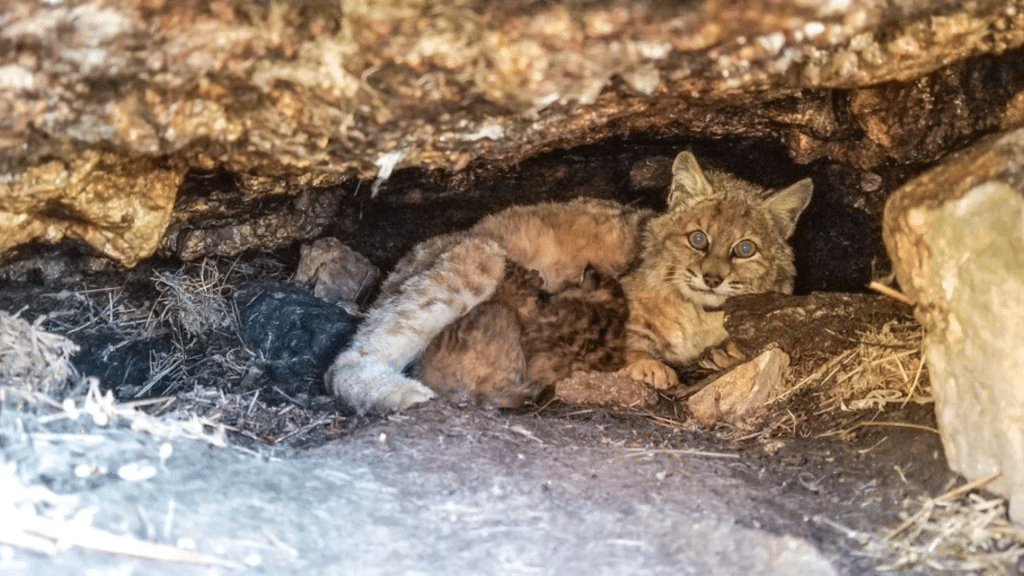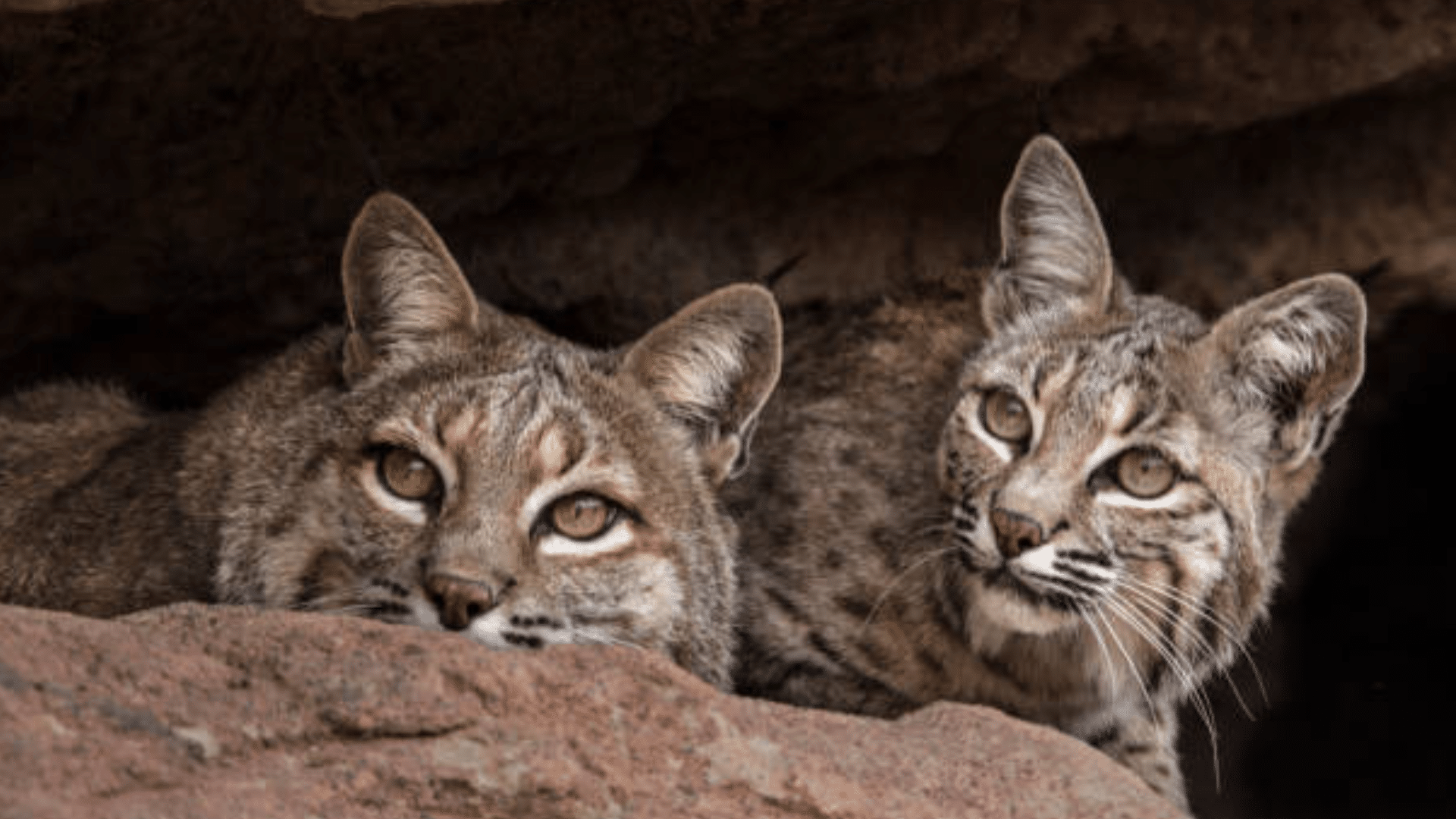Have you ever wondered where bobcats make their homes? These wild cats need safe spots to rest, raise young, and hide from danger.
The space a bobcat picks for its den must meet specific needs. These cats look for places that keep them hidden and protected from the weather and other animals.
The right den helps bobcats stay safe while they sleep and when mothers care for their kittens. Though bobcats try to keep their homes secret, certain clues can tell you when one might be nearby.
This article will show the main features of bobcat dens, where they build them, and some interesting facts about bobcat dens.
Everything You Need to Know About Bobcat Den
Bobcats create their dens in various places that offer safety and shelter. These wild cats often pick spots like hollow logs, rock piles, brush heaps, or small caves for their homes.
The main goal is to find a place that keeps them hidden from both people and other animals. A typical bobcat den has a small entrance that leads to a wider living area.
This design helps keep the den warm and makes it easier to defend. Most dens have one main entry point, though some may have a second exit for quick escapes when needed.
Bobcats line their dens with soft materials such as grass, leaves, moss, and fur. These items create a cozy base for sleeping and raising young.
The den area stays clean, as bobcats use spots away from their main den for waste. This habit helps keep their home free from smells that might attract other animals.
Where Do Bobcats Create Their Dens?
They often pick places with thick plants or rough land where people don’t go much.
These cats may use the same den for years or switch between several dens in their area. They tend to have main dens for raising young and other spots just for day rest.
Female bobcats need extra safe dens when they have kittens. They look for hidden spots that keep their babies safe from male bobcats and other dangers. The den location also needs to be close to food and water sources.
Preferred Environments and Locations for Bobcat Dens
| ENVIRONMENT | COMMON DEN LOCATIONS | SELECTION FACTORS |
|---|---|---|
| Forests | Hollow trees, fallen logs, tree roots | Good cover, hunting spots nearby |
| Rocky Areas | Small caves, crevices, rock piles | Hard for predators to reach, natural shelter |
| Brushy Areas | Dense thickets, brush piles | Hidden from view, many escape paths |
| Mixed Woods | Abandoned animal burrows, root systems | Protected from weather, close to the water |
| Swamp Edges | Raised dry spots, thick plants | Near water, plenty of food choices |
What Does a Bobcat Den Look Like?
Bobcat dens have several key features that help these cats stay safe and comfortable.
These homes may look simple from the outside, but they contain important elements that serve specific purposes for the cats and their young.
- Size: Most bobcat dens measure about 2-3 feet wide with a small entrance of 8-12 inches across. This compact size helps the den stay warm in cold weather and makes it easier for the bobcat to defend.
- Entrance: The opening is often partly hidden by plants, rocks, or other natural items. Bobcats choose entrances that allow them to slip in and out quickly, but might be too tight for larger predators to enter.
- Interior: The inside area is wider than the entrance and may have a rounded, bowl-like shape. This design gives the bobcat room to turn around, sleep comfortably, and care for kittens if needed.
- Bedding: Soft materials like fur, grass, leaves, and moss line the floor for comfort. The bobcat will regularly replace these materials to keep the den clean and free from pests.
- Cleanliness: The main sleeping area stays clean, with waste areas located away from the den. This habit helps prevent smells that might attract other animals to their home.
- Protection: Dens usually offer good views of the area while keeping the cat hidden from view. Many dens have spots where the bobcat can watch for danger without being seen.
- Marks: Scratch marks and tufts of fur near the entrance often show that a bobcat lives there. You might also notice paw prints or small paths leading to and from the den area.
Interesting Facts About Bobcat Den
Here are some facts that make bobcat homes special:
- Female bobcats often have multiple dens within their territory and will relocate their kittens between them to evade detection by predators.
- A mother bobcat keeps her kittens in the den for about two months before taking them out to learn hunting skills.
- Bobcats sometimes take over dens made by other animals, such as foxes, rabbits, or badgers, rather than creating their own.
- During winter in cold areas, bobcats pick dens with southern exposure to catch more sun and stay warmer.
- Unlike house cats, bobcats don’t spend much time in their dens except when sleeping, hiding from bad weather, or raising young.
- Some bobcat dens have been used by multiple generations of cats over several decades, with each new user making minor adjustments.
- Bobcats mark the area around their dens with scent from glands in their paws and faces to warn other bobcats to stay away.
Conclusion
Learning about bobcat dens helps us understand these shy cats better. These clever animals create homes that keep them and their young safe from danger and bad weather.
Now that you know what bobcat dens look like and where to find them, you might spot signs during your next nature walk. Remember to keep a respectful distance if you think you’ve found one.
What will you do with this new knowledge? Perhaps you could share it with friends who enjoy wildlife, or keep an eye out for den signs in your area.
For more about these smart wild cats, check out our other articles about bobcat habits and diet.





















